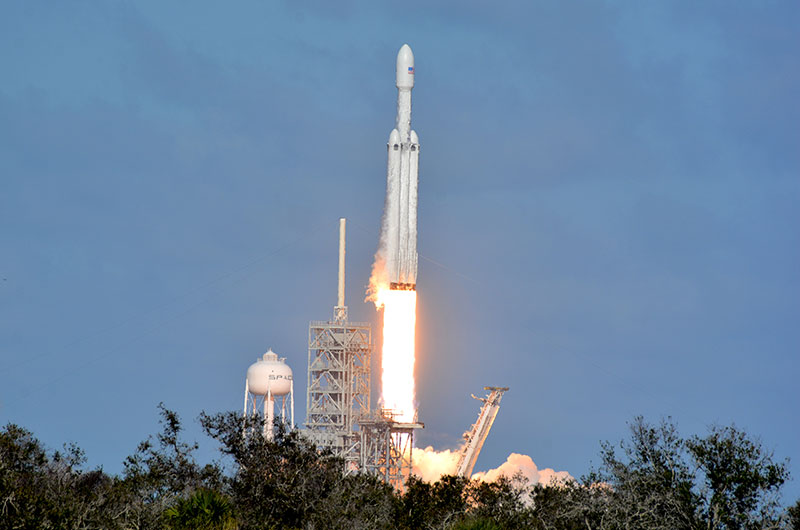 advertisements advertisements
|

|
SpaceX's Falcon Heavy lifts off on first flight of 'most powerful rocket'
February 6, 2018 — At T-5 seconds left in the countdown, 18 rocket engines — nine on each side-mounted booster — were given a go to start. Two seconds later, another nine on the vehicle's center core were commanded to do the same.
SpaceX's Falcon Heavy, now the world's most powerful operational rocket, lifted off on Tuesday (Feb. 6), riding atop the thrust of 27 engines on its first test flight.
The launch, from NASA's Pad 39A at the Kennedy Space Center in Florida, began at 3:45 p.m. EST (2045 GMT). The 230-foot-tall (70 meter) Falcon Heavy climbed upwards into the sky, departing the same launch pad where astronauts left for the moon and where space shuttles departed for Earth orbit in years past.
This rocket's payload, a mass simulator in the form of a cherry red Tesla Roadster, was headed on a billion-year journey circling the Sun on an elliptical orbit between Earth and Mars.
At a minute and six seconds into the flight, the Falcon Heavy encountered Max-Q, the point of maximum dynamic air pressure putting the most mechanical stress on the rocket.
One minute and 23 seconds later, the side-mounted boosters cut off their engines and dropped away from the center core. Each a reused Falcon 9 first stage that previously flew in 2016, they began their second descent to Earth, touching down on SpaceX's landing pads at Cape Canaveral Air Force Station just seven minutes and 58 seconds after they lifted off.
The center core, now flying alone, continued to climb for another 31 seconds, and then cut off its nine engines. Three seconds later, it separated from the Roadster-mounted second stage. Like the boosters, the core descended towards a planned landing, though on an ocean-based droneship. It ran low on propellant and hit the water hard and exploded.
The second stage fired its single engine, pushing the Roadster the rest of the way to space. The fairing that shielded the Tesla on its ascent through the atmosphere dropped away in halves just under four minutes into the flight.
The second stage cut off for the first time at about 125 miles (200 kilometers) over the planet at eight minutes and 30 seconds.
Coast, then boast (or rather, boost)
What happened next SpaceX had never tried before. Twenty minutes after its first shutdown, the second stage fired again for 30 seconds to put it and the Roadster on a six-hour coast to demonstrate the Falcon Heavy's capability to directly insert satellites into geosynchronous orbit.
The coast will take the second stage through the Van Allen belt, a concentrated band of radiation that surrounds the Earth. Elon Musk, SpaceX's CEO and chief designer, said the "grand tour" through the radiation belt could put the Roadster's journey out to Mars orbit in jeopardy.
"It is going to get whacked [by radiation] pretty hard," said Musk in a media call on Monday (Feb. 5).
"The fuel [for the second stage] could freeze and the oxygen [for the engine] could vaporize, all of which could inhibit the third burn which is necessary for trans-Mars injection," he said.
Even if the Roadster is confined to circle Earth, Musk said he would consider the maiden flight of the Falcon Heavy a success.
"If it clears the pad and hopefully makes it through transsonic, and Max-Q, I'd say those are big wins," said Musk. "And then if the booster's able to separate properly that is another big win, and then we are in a relatively normal regime because it becomes like a Falcon 9 at that point, apart from that very long coast mission that occurs after that, the long coast through the Van Allen belt."
If the demonstration mission is deemed a success, then Musk said SpaceX could be ready to launch its next Falcon Heavy with a commercial payload in three to six months.
Between Earth and Mars
If the second stage reignites for a third time, then the Falcon Heavy's first mission will last for a very, very long time.
"It is going to be in a precessing elliptical orbit, with one part of the ellipse being in Earth orbit and the other part being in Mars orbit. So essentially, it will be an Earth-Mars cycler and we estimate it will be in that orbit for several million years, maybe in excess of a billion years," said Musk.
"At times it will come extremely close to Mars and there is a tiny, tiny chance it will hit Mars," he said. "Extremely tiny." |
|

Photo credit: collectSPACE |

SpaceX's first Falcon Heavy rocket launches from Pad 39A at NASA's Kennedy Space Center in Florida on Feb. 6, 2018. (collectSPACE) |
|

© collectSPACE. All rights reserved.
|
|

|

|
